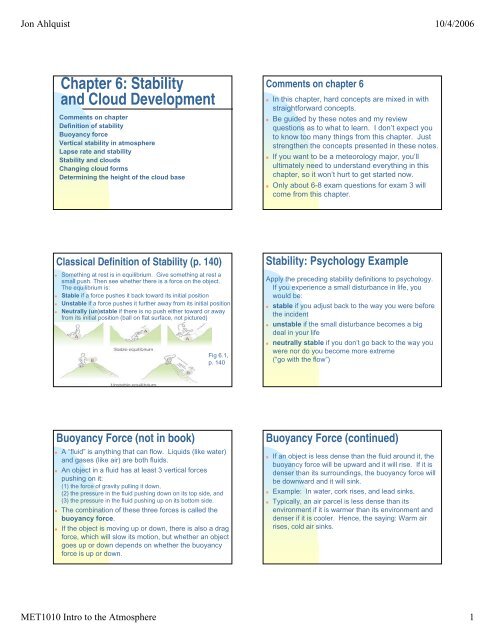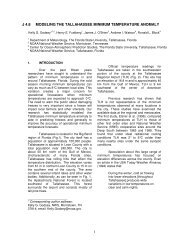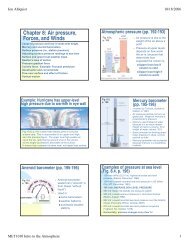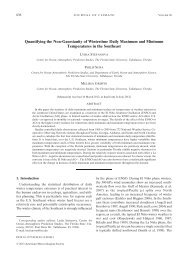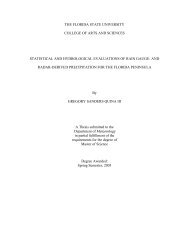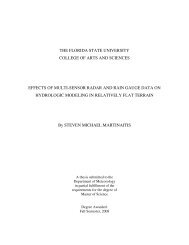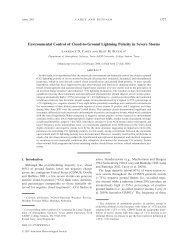Chapter 6: Stability and Cloud Development
Chapter 6: Stability and Cloud Development
Chapter 6: Stability and Cloud Development
Create successful ePaper yourself
Turn your PDF publications into a flip-book with our unique Google optimized e-Paper software.
Jon Ahlquist 10/4/2006<strong>Stability</strong> <strong>and</strong> <strong>Cloud</strong>s• Unstable conditions result in clouds with verticaldevelopment, such as cumulus congestus <strong>and</strong>cumulonimbus.• Stable conditions result in no clouds or stratusclouds <strong>and</strong> its variants, i.e., clouds with “stratus” aspart of the name. Recall “stratus” means(horizontal) layer, so stratified air is not moving upor down much.Example of clouds in stableatmosphere (col 2 of p. 154 & p. 155)• Air blowing over a mountain isshoved upward. If it cools tosaturation, a cloud will form:stratus lenticularis, also calledlenticular (lens-like) cloud• When air is stable, parcelsblowing over mountain sink onthe downwind side, goingbelow their original level• They bob up & down like acork on water as they traveldownstream. Other similarclouds can form downwind.Changing <strong>Cloud</strong> Forms (pp. 156-57)• <strong>Cloud</strong>s will change if the stability changes• To increase stability, decrease the lapse rateby:Warming air aloft (sun heats cloud top) <strong>and</strong>/orCooling air near surface (infrared radiation fromsurface)• Temperature inversion (i.e., zero or negativelapse rate) is very stable. The warm air is upabove, <strong>and</strong> the colder air is near the surface, sothe air stays put.Changing <strong>Cloud</strong> Forms (pp. 156-57)• To decrease stability, increase the lapse rateby:Cooling air aloft (cloud top cools by infraredemission) &/orWarming the surface (sun heats surface)• <strong>Stability</strong> can change without radiation iftemperature advection is different in upper <strong>and</strong>lower troposphere.Low-level warm advection & upper-level coldadvection increase instability.Low-level cold advection & upper-level warmadvection increase stability.Changing stability: Example 1• From morning to afternoon, the Earth’s surfacewarms, while the temperature 1000m & abovedoes not change much.Lapse rate increases because temperature contrastbetween surface <strong>and</strong> aloft increase<strong>Stability</strong> decreasesCumulus clouds often developCumulus congestus <strong>and</strong> cumulonimbus developwhen atmosphere is more unstableChanging stability: Example 2• When sun goes down, the Earth’s surfacecools, while the temperature 1000m & abovedoes not change much.Lapse rate decreases, <strong>and</strong> stability increases.Cumulus clouds <strong>and</strong> thunderstorms often dissipate• Explain how a low-level warm wind <strong>and</strong>/or anupper-level cold wind would decrease verticalstability.MET1010 Intro to the Atmosphere 3
Jon Ahlquist 10/4/2006Determining convective cloud baseheights (p. 153)• Cumulus clouds are often referred to as convectiveclouds because convection is rising motion• Cumulus cloud base will occur at height at which liftedair parcel reaches saturation• Cumulus cloud base may be:1000 m above ground in southeast US where relativehumidity is high. Because dew point near temperature,air does not have to rise much to cool to dew point.3000 m above ground in desert SW where relativehumidity is low. Dew point much lower thantemperature, so air must rise a lot to cool to dew point.MET1010 Intro to the Atmosphere 4


